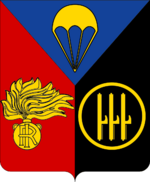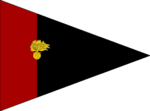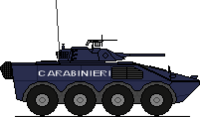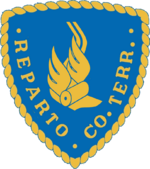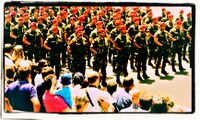Royal Carabinieri Operations Command (Kingdom of Italy)
| Royal Carabinieri Operations Command | |
|---|---|
| Comando Carabinieri Reali per le Operazioni | |
 | |
| Branch | |
| Role | Tactical operations |
| Commanders | |
| Current commander | Army Corps General Pietro Nuvolone |
The Royal Carabinieri Operations Command (Comando Reali Carabinieri per le Operazioni) is the Command with the mission of overseeing all surveillance operations, tactical control of the territory, personal security and mobile operations, including special operations under the responsibility of the Corps, which are decided by the Commander General.
The Command is also the main reservoir of personnel for missions abroad in support of the other Armed Forces for tasks other than the Military Police.
Mission
The Royal Carabinieri Operations Command, through its subdivisions, is tasked with:
- The primary fulfillment of the military duties of the Carabinieri associated with the integrated defence of the national territory and participation in military operations abroad;
- The performance of military police tasks against Italian Armed Forces deployed overseas;
- The support of the Carabinieri territorial organization in riot control activities and to increase the control of the territory in large urban areas and in the most sensitive areas in terms of public security;
- The participation in civil protection operations;
- The ensuring reserve of the General Command, a ready and reactive mass maneuvering force to cope with various emergencies.
Organization
The Command, headed by General of the Army Corps, is made up of the Command Office, the General Staff, one Division and three Brigade-level Commands:
- Mobile Units Division;
- Territory Control Command;
- Personal Security Command;
- Special Public Security Units Command;
- Air Service Command.
In addition to general officer-level commands, the Special Intervention Group is directly subordinated to the Operations Command.
Mobile Units Division
The Royal Carabinieri Mobile Units Division (Divisione Carabinieri Reali Unità Mobili, officially shortened in D.U.M. CC.RR.) is a Division-level command which controls all riot units, as well as other units specialized in military-type missions. The Division consists of a General Staff, of a Divisional Command and Tactical Supports Unit (with a Battalion, the Command Offices and a Command and Services Company employed) and seven operational regiments. Currently, CC.RR. Mobile units are subdivided into the support units and the riot units.
All such units may also be deployed in the Realms of the Italian Empire, should the need arise. Usually, four to six units are always deployed in the Realms of the Italian Empire on a rotatory basis, in order to provide support to the local governments and close protection to Italian quarters in Valona, in Tripoli, in Mogadiscio, in Asmara, in Tunisi and in Addis Abeba.
The Mobile Units Division coordinates and manages the mobile units of the Kingdom of Italy and of the Realms of the Italian Empire. The Mobile Units Division executes orders and directives of the Chief of Police and of the Commandant-General, places available resources at disposal of territorial police bodies, commands and controls extraordinary deployments for civil defence reasons and manages major events. In addition, the Mobile Units Division transposes and executes directives of the Joint Operational Command for the National Territory.
The Commander is a CC.RR. Division General.
Organization
The Mobile Units Division has a central organization resembling those of the Army Divisions, having a a General Staff and a Divisional Command and Tactical Supports Unit (with a Battalion, the Command Offices and a Command and Services Company employed).
- Liaison officer with the Public Order Office
- Liaison officers with information and security organizations
- Administrative Service
- Responsible for prevention and protection
- Legal Advisor
- Health Consultant
- Aide-de-camp
- Special Secretariat of the Commander
- Chief of Staff
- Personnel Office
- Intelligence Office
- Operations Office
- Logistics Office
- Planning Office
- Practice Office
- Financial Planning Office
- Doctrine and Innovation Office
- Training Centre
- Divisional Command and Tactical Supports Unit
- Protocol Office
Support units
Carabinieri support units are those units tasked with dealing with special assignments and sudden emergencies. These units are grouped within two Carabinieri Regiments:
 1st Royal Carabinieri Paratroopers Regiment "Podgora", consisting of three Battalions;
1st Royal Carabinieri Paratroopers Regiment "Podgora", consisting of three Battalions; 2nd Royal Carabinieri Cavalry Regiment "Pastrengo", consisting of three Squadrons Groups.
2nd Royal Carabinieri Cavalry Regiment "Pastrengo", consisting of three Squadrons Groups.
Riot units
CC.RR. Battalions are units intended for use on the national territory for the protection of public order. They are also used to assist the territorial organization, both in conjunction with the M.V.S.N. and alone. CC.RR. Battalions are led by a Lieutenant Colonel and depend on the Mobile Units Division, while the overall responsibility for the deployment is vested in the Public Order Office. Commanding officers mainly (but not exclusively) deal with non-operational issues, such as disciplinary matters, training, logistics. Overall, there are 17,440 troops in the Riot units.
The Mobile Units Division controls 24 riot Battalions headquartered in various cities for a total of 25,000 men assigned to riot suppression tasks. These Battalions are grouped into five Regiments:
 4th Carabinieri Regiment "Torino": HQs in Turin, in charge for riot Battalions based in Turin (I Carabinieri Battalion), Moncalieri (Turin province, II Carabinieri Battalion), Milan (III Carabinieri Battalion), Genoa (IV Carabinieri Battalion) and Brescia (V Carabinieri Battalion).
4th Carabinieri Regiment "Torino": HQs in Turin, in charge for riot Battalions based in Turin (I Carabinieri Battalion), Moncalieri (Turin province, II Carabinieri Battalion), Milan (III Carabinieri Battalion), Genoa (IV Carabinieri Battalion) and Brescia (V Carabinieri Battalion). 5th Royal Carabinieri Regiment "Padova": Padua (VI and VIII Carabinieri Battalions), Udine (VII Carabinieri Battalion), and Bologna (IX Carabinieri Battalion).
5th Royal Carabinieri Regiment "Padova": Padua (VI and VIII Carabinieri Battalions), Udine (VII Carabinieri Battalion), and Bologna (IX Carabinieri Battalion). 6th Royal Carabinieri Regiment "Roma": HQs in Rome, in charge for riot Battalions based in Rome (X and XIV Carabinieri Battalions), Florence (XI Carabinieri Battalion), Senigallia (XII Carabinieri Battalion), and Perugia (XIII Carabinieri Battalion).
6th Royal Carabinieri Regiment "Roma": HQs in Rome, in charge for riot Battalions based in Rome (X and XIV Carabinieri Battalions), Florence (XI Carabinieri Battalion), Senigallia (XII Carabinieri Battalion), and Perugia (XIII Carabinieri Battalion). 7th Royal Carabinieri Regiment: HQs in Cagliari, in charge for Riot Battalions based in Cagliari (XV Carabinieri Battalion), Sassari (XVI Carabinieri Battalion) and Ajaccio (XVII Carabinieri Battalion).
7th Royal Carabinieri Regiment: HQs in Cagliari, in charge for Riot Battalions based in Cagliari (XV Carabinieri Battalion), Sassari (XVI Carabinieri Battalion) and Ajaccio (XVII Carabinieri Battalion). 8th Royal Carabinieri Regiment: HQs in Naples, in charge for Riot Battalions based in Naples (XVIII and XXIV Carabinieri Battalions), Bari (XIX Carabinieri Battalion), Catania (XX Carabinieri Battalion), Palermo (XXI Carabinieri Battalion), Reggio Calabria (XXII Battaglione Carabinieri) and in Taranto (XXIII Battaglione Carabinieri).
8th Royal Carabinieri Regiment: HQs in Naples, in charge for Riot Battalions based in Naples (XVIII and XXIV Carabinieri Battalions), Bari (XIX Carabinieri Battalion), Catania (XX Carabinieri Battalion), Palermo (XXI Carabinieri Battalion), Reggio Calabria (XXII Battaglione Carabinieri) and in Taranto (XXIII Battaglione Carabinieri).
CC.RR. Battalion organization
Each CC.RR. Battalion is 710-Carabinieri strong and it is organised into:
- Command Company (5 Officers, 2 Medical Officers, 12 Subofficers, 4 Medical Subofficers and 77 troops);
- Command Platoon, for the management of of general affairs, personnel, training, warehouse and armoury and for asset management and accounting (Commander, Deputy Commander, 3 Subofficers and 17 troops);
- Vehicles Squad for the Battalion's fleet technical maintenance (1 Subofficer and 16 troops);
- Judicial Police Squad (2 Subofficers and 6 troops);
- Telecommunications Squad, for the management of the communication devices (1 Subofficer and 9 troops);
- NBCR Unit (1 Officer, 1 Subofficer, 12 troops);
- Logistics Office for catering activities (1 Subofficer and 9 troops);
- Political, social and recreational Office (1 Politcal Officer, 1 Officer, 3 Subofficers and 10 Troops);
- Health Squad, for the protection of health (2 Medical Officers, 4 Medical Subofficers and 8 troops).
- Operational Companies, 200 men each (4 Platoons): Royal Carabinieri Battalions generally have three Companies.
All CC.RR. Battalions are grouped within the Mobile Units Division and in five Regiments, although the Division has only general coordination tasks and some de facto autonomy is ensured. The Provincial Authority of Public Security requests the use of CC.RR. Battalions, and the Director General of Public Security orders the deployment, together with the special vehicles. The minimum operational level is the 10-men Team. Each Platoon is fully motorised and can be deployed also as a mechanised force if necessary to counter external invasion attempts.
The added value of the CC.RR. Battalions is represented by the deployment of Carabinieri trained together and used to live and fight together.
Seclusion
CC.RR. Battalions are maintained in virtually self-sufficient compounds and are trained to work as a coordinated force not only in riot control techniques but also in urban combat. Officers live in dormitories within riot barracks compounds. Training is continuous and focuses on physical conditioning, mock battles, and tactical problems. Riot units barracks are the Police places where the military atmosphere prevails, in a even more pronounced manner than in the rest of police corps: dress codes, behaviour standards, and rank differentiations are far more strictly adhered to than in the territorial organization of the Carabinieri.
Riot duty is not very popular because it entails special sacrifices and much boredom in between irregularly spaced actions. Only a minor part of police officers serving in riot units are volunteers. For many personnel, riot duty serves as a stepping stone because of its reputation and the opportunities it presents to study for the advanced police examinations necessary for promotion. Because riot duties demands physical fitness, most personnel are young, sometimes serving in the units after an initial assignment.
CC.RR. Battalions' motto is "First to arrive, last to give in" (it: "Primi ad arrivare, Ultimi a cedere"). Carabinieri believe, obey, fight. Their function is to ensure public order, at present and in the future. Unlike the rest of Public Security apparatus, men staffing the special and riot units are particularly committed towards Fascism, also due to intensive ideological training.
Training
All Royal Carabinieri undergo specialization and training to serve in Battalions. General training is carried out at basic Schools, while specific training is carried out at the Training Centre for Public Order, where the Shock Operations Course is offered, and refrehment coures are held, on a regular basis, at regimental headquarters.
Military training is carried out at Army tactical training centres.
Riot-control equipment
CC.RR. Battalions use a series of equipment items, in order to enable Carabinieri to successfully contrast and quell any riot or protest and, at the same time, protect the police officer.
Personal equipment
The primary offensive weapon is the 74 cm-long straight-stick baton. It is a long cylinder with a wrapped grip, with a slightly thicker shaft and rounded tip. They are made of aluminium covered by rubber. A variant is a 91 cm-long "riot batons", used in civil disturbances by officers mounted on horseback. Other Public Security personnel use the expandable baton, which is easier to carry while in a vehicle. It is not permitted to hit with the baton the skull, sternum, spine, or groin unless such an attack is unavoidable. The primary targets are nerves and large muscles.
Riot shields are protection devices deployed by mobile units. Riot shields are long enough to cover an average sized man from the top of the head to the knees. They are used in riot control, to protect the user from shrapnel, thrown projectiles, and splash from various weapons such as a Molotov cocktail. They can also be used as short-ranged hand-to-hand combat weapons to push back rioters. Riot shields are constructed from transparent high-impact plastic to enable the bearer to see incoming thrown objects, so the shield can quickly be positioned to deflect them away from the policeman's body. Riot shields are rectangular with rounded corners, curved in the horizontal cross-section to shed thrown objects. The size is 70 cm to 100 cm.
The riot helmet is used to protect its wearer's head, face and eyes from handheld melee weapons, and thrown projectiles such as bricks, as may be met in riot control. The basic form is a hard shell with reinforced padding, and a chinstrap and a hinge-up visor. Visors are curved sideways and straight up-and-down. Accessories include a back-of-the-neck protector, the built-in radio microphone and earpieces. Newer models include a double visor: the outer visor is clear and hinges up outside the helmet, while the inner visor hinges up between two layers of the helmet and has a finish which can be seen through from inside but from outside looks like opaque polished brass.
Riot uniform
The uniform of the riot and special units reflects Royal Carabinieri colours, but it has specific features. Riot dress consists of a field-type jacket, which covers several pieces of body armour and includes a corset hung from the waist, an aluminium plate down the spine, and shoulder pads. Armoured gauntlets cover the hands and forearms. Helmets have face plates and flared padded skirts down the back to protect the neck. The ranks carry 1.2-meter shields to protect against stave and rocks. Specially designed equipment includes water cannons, armoured vans, and mobile tunnels for protected entry into seized buildings. Each trooper also wears a radio with an earpiece to hear commands given simultaneously to the unit he belongs to.
The CC.RR. riot uniform consists in a black coat with zipper, behind which appears the detachable inscription "CARABINIERI" in reflective fabric and trousers gray blue equipped with side pockets. Both pants and jacket are in fireproof fabric and internally reinforced. The uniform includes the black beret with badge and the black tactical vest with pockets. The pockets of the tactical vest staying grenades and radio. The uniform also includes a black sweater turtle-neck (in summer it is replaced with a black polo T-shirt with the script "CARABINIERI"), Cordura belt and crimson coloured handkerchief that wraps around the neck, black infantry boots.
Vehicles
The Royal Carabinieri Battalions are tasked to carry out the military role of Mechanised Infantry units. Therefore, Carabinieri may deploy "soft" vehicles such as police vans and lightly armoured infantry vehicles, but they can deploy infantry fighting vehicles (mainly VCC Puma armoured cars, but also VIC Freccia, VIC Dardo) and TT-12 armoured personnel carriers. This provides for an heavier confrontation with demonstrators, and a reduced capability to handle peaceful resolutions of non-authorised gatherings or a relatively "soft" disbandment of opposition. However, differently from "M" Battalions, they are not ordinarily tasked to act as the first link in extremely serious civil confrontations and may be deployed in the Italian Empire.
Support vehicles are also used, such as water cannons (IVECO ACA-10000, with a 10,000-liters tank), mobile barrier vehicles (IVECO BM-5000) and others.
Territorial Control Units Command
The Royal Carabinieri Territorial Control Command (Comando Carabinieri Reali Unità Controllo Territoriale) is the Brigade-level subdivision tasked with identifying and developing strategies for general prevention and control of territory. In addition, it coordinates the use of all resources allocated to prevention, at both central and peripheral levels. The Territorial Control Units Command deals with central management tasks, ensuring the monitoring of the various territorial instruments. For these needs, the Command makes a constant study, research and even international interchange.
The Territorial Control Units Command consists of a General Staff, of the 3rd Royal Carabinieri Support Regiment "Volturno", and of 32 Territorial Control Units directly dependent on the Command for matters related to training and equipment, while the operational use is up to the Royal Carabinieri Legions and Provincial Commands.
3rd Royal Carabinieri Support Regiment "Volturno"
The 3rd Royal Carabinieri Support Regiment "Volturno" is the Royal Carabinieri unit which groups the 5 Carabinieri Counter-guerrilla Battalions head-quartered in Cagliari, Vibo Valentia, Naples, Rome and Milan.
The Royal Carabinieri maintains five Carabinieri Paratroopers Counter-guerilla Battalions (Battaglioni Carabinieri Paracadutisti Antiguerriglia), head-quartered in Cagliari, Vibo Valentia, Naples, Rome and Palermo. The Cagliari Battalion maintains the traditional name of Banditry Prevention Unit (Reparto Prevenzione Banditismo). The Battalions have uniforms, armament and equipment specifically designed for the particular type of service performed.
While centrally managed, their operations are planned and executed under the aegis of the relevant Royal Carabinieri Legion. In wartime, each Paratrooper Carabinieri Counter-guerilla Battalion is to be integrated within an individual Army Alpine Brigade.
Territorial Control Units
The Territorial Control Units (Reparti Controllo Territoriale, R.C.T.) depend directly on the Territorial Control Section, which plans to use them, and makes them available to the various Legions and/or Provincial (or Group) Commands. The use of the 32 Territorial Control Units (commanded each by a Major) is planned by the Territorial Control Units Command in relation to the demands of the Provincial and Legion Commanders, particularly when local resources are not sufficient. Legional Public Security Services and Operational Departments are organically inserted into Carabinieri Legions and Provincial Commands, respectively: these bodies direct the work of the Territorial Control Units on the ground. Territorial Control Units and mobile units are trained to effectively cooperate together.
The Territorial Control Units are dispersed through the national territory, and may be quickly depoloyed where most needed. As of 2020, there are 32 Territorial Control Units for a total of more than 2,700 personnel:
|
|
|
|
Equipment
Because the first Territorial Control Unit was established in 1976 within the Highway Police Service under the name of Anti-Crime Special Unit (Reparto Speciale Prevenzione Crimine), the personnel assigned to the Territorial Control Section still wear Rosso corsa berets and the Highway Police Service uniforms, although with their own sleeve insignia. The Reggio Calabria Territorial Control Unit has a specially-trained Special Control Group (Gruppo Controllo Speciale, G.C.S.), tasked to provide support against organised crime and dangerous fugitives on the whole national territory.
Organization and employment
The Territorial Control Unit is a Company-level subdivision. The commanding officer, usually a Major but sometimes a Captain, is in charge of the administrative support and of the command and disciplinary activity. There are usually 30 3-men strong crews in each R.C.T. On operations, the Unit operates convoys consisting of two crews (under a Brigadier) or three to four crews (under a Marshal). Usually, the approach is to organize small convoys in order to effectively address issues.
Personal Security Command
The Royal Carabinieri Personal Security Command (Comando Carabinieri Reali Sicurezza Personale) is the entity responsible for the personal security. The Ministry of Interior, through the Directorate-General of Public Security and the General Command of the Royal Carabinieri, ensures the carrying out of personal protection services outside the Duce and the military. The Personal Security Division is led by a Division General and employs 2,793 Royal Carabinieri.
The functional area of responsibility relates to the preservation and protection of eminent persons (both for institutional and political reasons) both domestic and foreign, as well as persons who are subject to hazards or threats, in the person of his or her family. Outside of the high political personalities, the dangers which the Personal Security Division must respond to are of a terrorist nature or related to organized crime, drug trafficking, arms trafficking or radioactive material trafficking. Finally, the Division is responsible to avoid the dangers related to activities of foreign intelligence. The Division may also adopt measures to arrange flights to ensure the safety of the leading figures or other persons subject to dangers or threats.
The special tasks of the Division include the collection and analysis of all the information related to personal situations at risk that O.V.R.A., the Military Information Service, the Confidential Affairs Division, the judiciary, the police and security forces and the M.V.S.N. are required to provide, taking care also connections with the provincial offices. The Division also deals with the services and personnel strategic and operational planning, technical training of personnel employed in the security services and the check of the special tools used for protection services and their supervision. Finally, the Division also provides the activation of emergency procedures.
The head-quarters personnel can be assigned to the Division from all State administrations and corps, from all security forces, both Party and State ones, while the security services and surveillance are carried out from specialized offices and units of Royal Carabinieri or the M.V.S.N.
For reasons of exceptional and temporary nature, drivers of vehicles in use at high personalities may be granted the powers and the functions of Agent of Public Security, in order to allow the performance of a more effective action to prevent and protect the life of these personalities. Drivers appointed Agents of Public Security are allowed to use in vehicles conducted siren and revolving blue light beacon. The Personal Security Division consists of seven Offices and a Central Advisory Commission:
- Office I - General Affairs and plans;
- Office II - Analysis;
- Office III - International relations: support to INTERPOL and relations with foreign police bodies for protection tasks;
- Office IV - Operations;
- Office V - Training;
- Office VI - Logistics;
- Office VII - Static surveillance;
- Central Advisory Commission.
- Central Protection Section
Central Advisory Commission
The Central Advisory Commission (It: Commissione Consultiva Centrale) is a body of the Division; the Commission, at the request of the Divisional Head, provides its opinion on the adoption, modification and revocation of protection measures and surveillance, as well as on all other matters, related to measures of protection and supervision, that the Director deems to submit.
The Division uses the Commission for the adoption of protective and supervision measures. The Commission is chaired by the Divisional Commander and consists of one representative from each of the police forces involved (including civilian officials), a representative of the O.V.R.A., a representative of the Militia, a representative of the Military Information Service, and three representatives of the National Fascist Party.
Central Protection Section
The Central Protection Section (Sezione Centrale di Protezione, S.C.P.) implements special programs of protection and assistance to witnesses and other protected persons. The assistance programs include reintegration into social and working context. The Section also maintains relations with the Judicial bodies and Public Security peripheral organs, as well as with all the other ministries involved in the implementation of protective measures. The Section has as its own support structure 11 Inter-Provincial Operational Offices. The Section in turn consists of 6 Offices: General and Anagraphic Affairs, Psychological support, Economic support, Witnesses, Collaborators of Justice and Special and Temporary Programs.
Peripheral organization
Any measure taken by the Divisional Commander is communicated to the Prefect and the Provincial Commander of the province affected by the execution of the decision adopted. In every Prefecture, as part of the Sixth Division, operates the Provincial Office for Personal Security, responsible for collection and preliminary analysis of information related to personal situations at risk, as well as information connections with the Central Directorate. The Office makes use of the Royal Carabinieri, M.V.S.N. and officers specifically designated and appointed. The Prefect convenes and presides special coordination meetings, with the participation of the Provincial Commander, the commanders of the other police forces that may be present in the Province, the M.V.S.N. Commander and the official in charge of the Office for Personal Security. It can also be summoned on the Federal Secretary of the P.N.F.
The Prefect, relying upon data collected and on coordination meetings, makes recommendations to the Division.
Explosives Disposal and Nuclear, Radiological, Biological and Chemical Defence Service
The Explosives Disposal and Nuclear, Radiological, Biological and Chemical Defense Service (CBRN; Italian: Servizio Artificieri e Difesa NBCR, SADINBCR) is the specialized body of the Royal Carabinieri in the prevention and general action in the event of incidents related to devices of an explosive, incendiary, nuclear, radiological, biological or chemical nature, especially in terms of location, recognition, neutralization or deactivation, as well as as, to technically direct and maintain the operation of the CBRN Defence System of the Royal Carabinieri, designed for intervention in serious emergency situations.
Central level
The central body of the CBRN SEDEX is structured into a Command on which the following units depend:
- Explosives Disposal Central Operating Unit
- Subsoil Reconnaissance Unit
- CBRN Central Operating Unit
Central Operating Unit for Explosives Disposal
The Central Operating Unit for Explosives Disposal attends to all tasks related to the search, neutralization and deactivation of explosive devices, being able to support other groups of specialists from the peripheral organization.
Subsoil Reconnaissance Unit
The Subsoil Reconnaissance Unit is the unit specialized in reconnaissance, surveillance, protection and security in the underground networks of buildings, facilities, infrastructures, itineraries and any other scenario in which the use of specific material resources is required. assigned to the unit, as well as safety studies related to this medium.
CBRN Central Operating Unit (CBRN UCO)
It corresponds to the Control Unit specialized in threats with aggressive CBRN, which corresponds, among other specific tasks, and to make the operational technical direction of the intervening personnel or intervention in those cases that require a high degree of CBRN specialization
Territorial level
The units of the peripheral organization, with respect to their capabilities, are established at Provincial and Legion Commands:
- Provincial Explosive Disposal Squads;
- Provincial Explosive Ordnance and CBRN Search and Location Squads;
- Provincial CBRN First Response Squads: designed to act initially in a CBRN emergency situation, adopting basic preventive and reaction measures;
- Legion CBRN Protection and Intervention Units: eminently technical, are specially designed to intervene in situations of CBRN threats or risks.
Special Public Security Units Command
The Carabinieri Public Security Special Units Command (Italian: Comando Carabinieri Unità Speciali per la Pubblica Sicurezza) or shortly as C.C.U.S.P.S., is the domestic special forces unit of the Carabinieri. It has several missions which include counter-terrorist actions, urban warfare, underwater operations, hostage rescue, riot control, and other high-threat criminal actions and, for military duties, direct actions, as well as support to special operations forces. Members of the unit receive extensive training from selected Army instructors and also at the Police Schools. The Command is Regiment-sized (four Battalion-sized Groups) and depends only on the Carabinieri General Command; it is to note that the Command lies outside the Mobile Units Division, because its units are employed in confidential missions unrelated to the public order protection. All companies work under the direction of the Police and Carabinieri regional commands to which they are assigned, but can also receive tasking from Rome.
Special Intervention Group
The Special Intervention Group (Italian: Gruppo Carabinieri Intervento Speciale, G.I.S.) is a special police unit of the Royal Carabinieri, tasked to provide both military-related and police-related duties.
The Special Intervention Group is the special operations unit of the Carabinieri. It has several missions which includes search and destroy, infiltration and reconnaissance actions. Members of the unit receive extensive training at the Carabinieri School and also from selected Army instructors. All three companies work under the direction of the Army regions to which they are assigned, but can also receive tasking from their headquarters in Rome.
Being a military organization, the unit is fully deployable abroad and, when necessary, it can be integrated with other F.S.-level units (e.g. Operation Sarissa in Afghanistan and Operation Ultor in East Africa). The Special Intervention Group is a purely counter-terrorism unit, specialised in both military (insurgent) and domestic threats.
Air Service Command
The Royal Carabinieri Air Service (Italian: Servizio Aereo dei Reali Carabinieri, S.A.R.C.) is the Royal Carabinieri command which provides air support to all operations of the Royal Carabinieri (both police-related and tactical ones).
Air power is functional for man-hunting, mopping-up, blocking, searching for fugitives, escapees, robbers, kidnappers, and missing persons, allowing the identification of locations and objectives of interest, allowing pollution control and execution of control over compliance with special laws. In public order services, air power allows the sighting and signaling of mass movements or groups on the ground, allows video shooting, contributes to safety stock and road traffic control. Helicopters provide the element through which the areas affected by major disasters are surveyed, including search and rescue on land or water surfaces (in cooperation or not with other relief units) and interventions in favor of populations affected by natural disasters or other special circumstances. The operational transport of dogs, divers, paratroopers, other units, special purpose units, personnel of the Arma for service reasons and rescue teams is also carried out by helicopter, as well as that of various materials, medicines, food and supplies in general. Finally, air power is essential in special police operations, in objective re-acquisition operations, in hostage release operations, in operations aimed at preventing the commission of offenses, as well as in high-risk capture operations and in stocks of personalities of importance.
